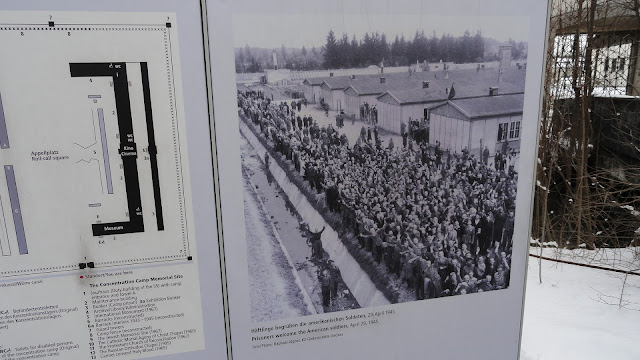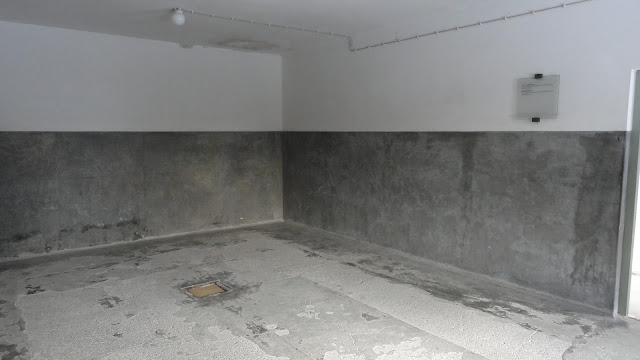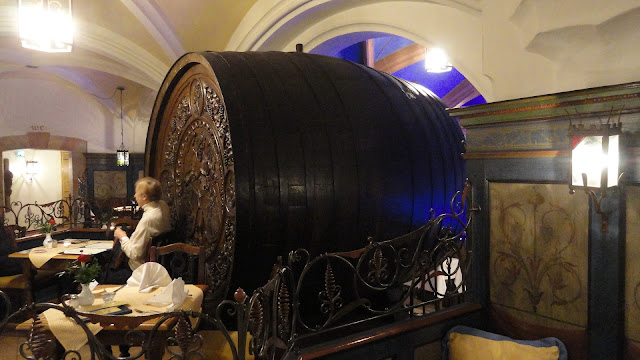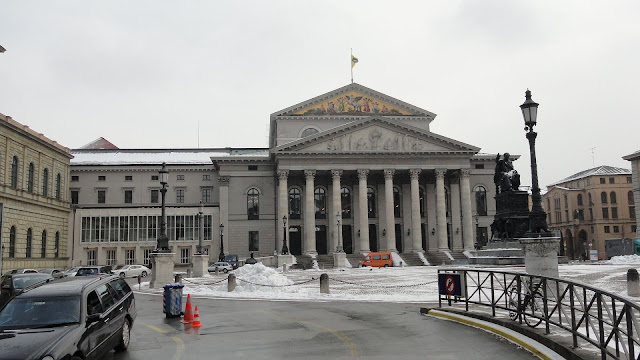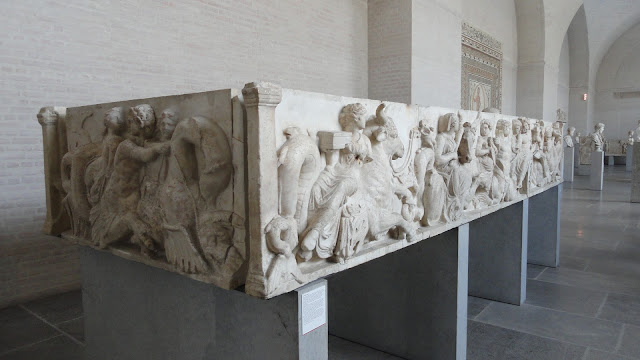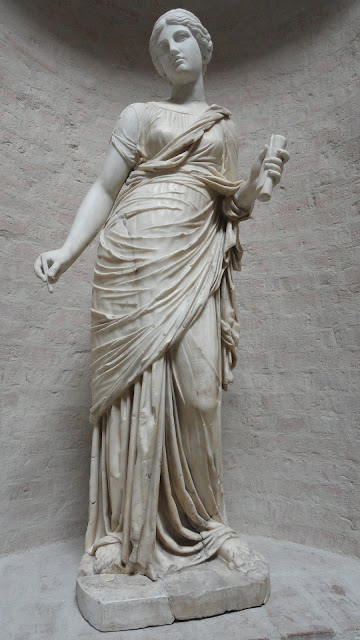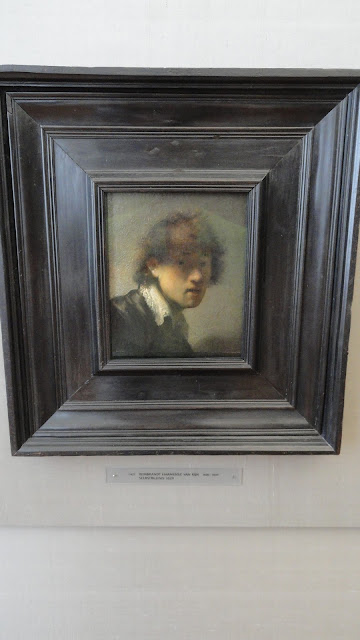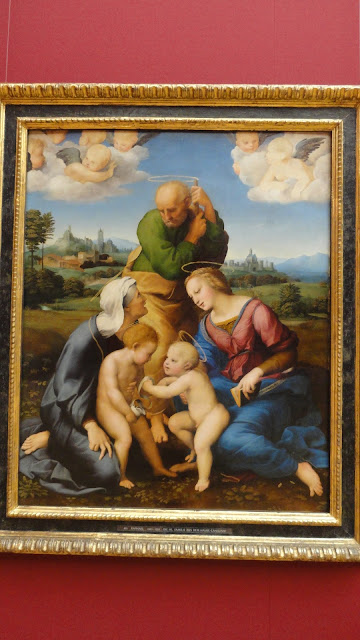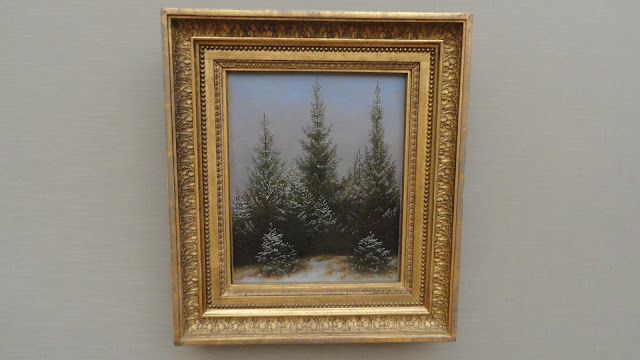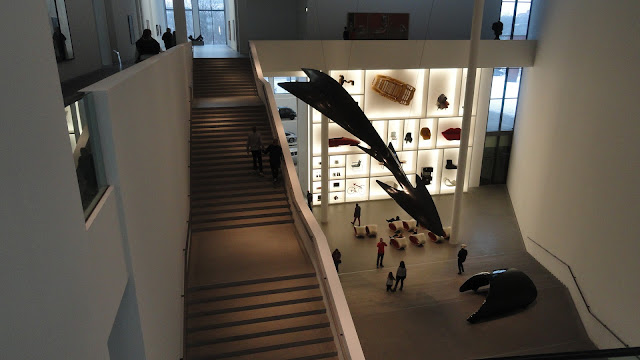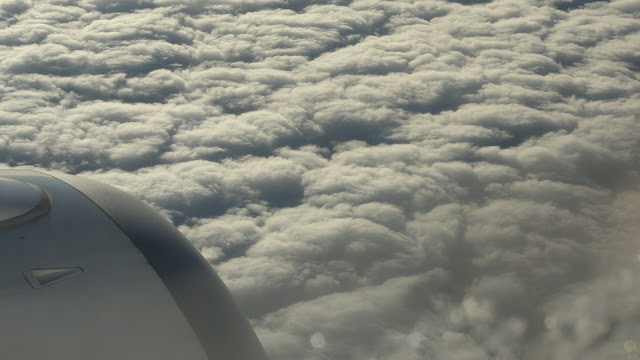Thursday - After our fantastic start to the vacation we settled down in Munich for the duration to explore what the town has to offer. Unfortunately the good weather was behind us. For the rest of the trip we had highs in the upper 20's F and lows in the teens F with snow falling on us and wind whipping our faces most of the time. I had been sick the week before we left and now we all shared in my misery. Coughing, hacking and feeling a little sluggish we all scarfed down our medicines and made the best of it as our conditions gradually worsened.
The morning view from mine and KJ's hotel room. Starting to miss Switzerland.
Our final trip with the car was to Dachau Concentration Camp (Jewish Library Link) or (Wiki link). The infamous camp is next to the town of Dachau (hence the camp name) and was an information overload. I knew a lot of the information already as wars interest me and all things World War II are readily available on TV or in book. Karl previously mentioned that this as a place to visit when we first moved to England so I was glad we were able to make it. Lori wanted to come here as well and Kalle learned a little about it in school this year so I figured this would be an informative stop for all of us. We arrived at opening time, paid for our tickets, and double timed it inside as the coaches full of school trip students started to pull in.
Jim Seppanen Pic - The maintenance and services building through the trees. It now houses most of the literature and a movie room that showed an excellent 22 minute movie on the camp. One interesting part of the movie was them referencing to the Nazi Party as terrorists. I don't think I have ever heard that reference before.
The entrance to the prisoners area of the camp. The camp was actually huge, the prisoners portion was only part of it. The rest of the camp housed the Nazi soldiers, had an armament factory, administration buildings, rail car station, etc. - later on will be a picture of the camp model.
The grim start of the camp history. Not a very happy tour but required for families and children in my opinion.
Diagram of the memorial site. We are standing at number 1.
Picture as the Americans are liberating the camp. A couple of plaques commemorate the liberation by the US 42nd Rainbow Division, 7th Army, and 20th Armored Division.
Roll call was year round and prisoners were not given any extra clothing in the wintertime.
One of the two prisoner barracks that are still standing. The other barracks have been torn down.
Barracks foundations in front and a guard tower on the left.
Tammy Foster Pic - Maybe the most grim bridge pic I will post. This bridge leads to the crematoriums. They don't know how many people were killed here, they kept detailed records up until the end of the war but didn't count how many of the hated Soviets they killed. They also didn't count how people were killed or burned in the final few months of the war but it did say the crematoriums ran night and day for many months until they ran out of coal for the ovens. Dachau was more of a work camp (local armament factory and coal mines) than a death camp but this was used as the model for the rest of the concentration camps.
The crematorium area.
The first crematorium.
Indescribable feeling standing here thinking of people being burned to ashes. The camp guards made other prisoners run the crematoriums. There were some stories that prisoners running the crematoriums and performing other such jobs were crueler to their fellow prisoners than the camp guards were. Humanity was rare here during the war.
The second crematorium. The amount of planning and design they put into this assembly line of death was sickening.
Stacking the dead in a pile before they are burned. Inhuman.
The clothes were disinfected before they were reused to cut down on diseases. Hard to imagine but they treated the clothes better than they did the humans.
A gas chamber used to disinfect the clothes.
The Waiting Room where the prisoners were told they would be taking "showers" before joining the general population.
The Disrobing Room where prisoners would strip naked before entering the gas "showers". The clothes would be removed to the disinfecting chambers before the next round of prisoners would enter and prepare for their "showers".
The Gas Chamber where 150 people could be suffocated in 15 to 20 minutes. Prussic acid poison gas (Zyklon B) was used to suffocate the prisoners.
Death Chamber 1 where the bodies were kept before being put into the ovens.
The Incinerator Room, each of the four furnaces could burn two or three corpses at once. The rafters overhead would be used to hang prisoners before putting them into the furnaces.
Death Chamber 2. The American liberators were so upset and disgusted by the camp they rounded up all the Dachau town residents and made them march through the camp. Here are some townsfolk walking through Death Chamber 2. The townsfolk claimed ignorance on what was happening at the camp but there was some questions on how much they really knew. One item that surprised me was how much work was done by the prisoners outside of the camp in the town and surrounding areas. There were some stories of townsfolk being kind to prisoners and even smuggling contraband such as food, clothing and even a camera into/out of the camp.
Outside the crematorium was this pistol execution range.
The second crematorium.
The length of the prisoners camp.
Model of the entire camp circa 1945. The prisoners camp (which is now the memorial site) is the rectangle on the right.
In the main section of the memorial site was the information overload. More pictures and stories than anyone can read and absorb in a day. This picture shows prisoners working in an armament factory on left, mine in middle, and liberators entering a different camp. When the Americans were closing in the Nazis killed as many prisoners as they could. Another picture described the Nazi policy of forcing abortions on pregnant female prisoners.
Some boards told the stories of individual prisoners. The Jews, gypsies, and homosexuals were treated the worst (abused, tortured, experimented on) while the Soviet officers were generally killed immediately. The Italians also joined that list once Italy surrendered.
Hard to believe but true.
Your mood ranges between disgusted anger and almost rage at different points as you walk through the museum and read the boards. I do have to say that nothing was sugar coated or omitted here which made the museum a little easier to stomach.
One of the many gruesome experiment pictures. A really disgusting one was the experiment to revive cardiac activity after clinical death in a pressure chamber. Why?
The American liberators were so disgusted and enraged that they executed some of the officers and guards until the battalion commander stopped the US soldiers.
I saw a show on her. The four women have a plaque in the second crematorium commemorating their courage and sacrifice.
An example of the prison labour force.
Whipping bench and bull whip. Another form of torture used on the prisoners was "pole hanging" where prisoners have their hands tied behind their backs then are hung from their wrists. Their hanging body weight rips apart their shoulders.
Evolution of the camp. It started as a regular prisoner camp (see the prisoners lockers with their own meal dishes and utensils) then turned into the sickening camp it was at the end.
The defendants of the "Hitler Putsch", WIki link, we'll revisit this later in Munich.
The result of the treaty devastated Germany which led to World War II which then led to The Marshall Plan in order to prevent World War III. Thanks for the education Mr. Wadaga (my high school Civics class teacher).
Propaganda posters.
The lockers from an earlier picture. Not sure what they were used for once the camp turned into hell.
Prisoners bunks. The movie said that five men would sleep in each two person bunk.
The museum (old maintenance and services building) on left and prisoner camp entrance on right. Picture taken from the barracks.
Hard to describe the range of feelings you experience as you go through the site but I highly recommend it for anyone in the Munich area. I have to give a lot of credit to the people who made this a memorial site and decided to show an unfiltered view of the camp. Very powerful.
Time drop off the Mercedes-Benz at the airport. We opted for a quick lunch at the gas station - convenience store and even that quick meal tasted good. <Sigh> After sadly turning in the car I activated our three day Munich Tourist card which included public transportation around Munich and to/from the airport. Hello trains, goodbye walking. Another bonus of Germany, trains are on time or early and run great. Check out that foreign concept England!
The kids on the S-bahn, or surface train.
The outside of the S-bahn for the curious Ben Fosters in the audience.
The inside of the U-bahn, or underground train.
The outside of the U-bahn. Sorry Kalle, the other picture I had of the U-bahn was worse.
Since we were outside Munich already we decided to get our BMW fix. The BMW Welt (World) and Museum are north of the city. The BMV Velt (as the Germans pronounce it) was free and interesting (official link).
Kalle standing by a clown car.
There was also a Rolls Royce section at BMW Welt. According to the wall next to this Phantom, every Rolls Royce car is hand-built by sixty pairs of hands (from design to assembly) in Goodwood, England.
I liked this BMW i3 Concept car. See below for the assembled car.
For above.
There were some BMW models here. Lori liked this colour.
For the car below. The 20 mile electric range caught my eye.
Another concept car, read the specs above.
Another racing simulation. Kalle is showing off her one hand on wheel, one hand twirling hair racing style. I think Karl won after Kalle crashed through a few buildings.
There also was a mini Mini section.
BMW World on our way out. The gift shop had some really nice apparel but it was also really nicely priced. So we went to the museum.
The famous BMW Towers with their four cylinder design. The bowl on the right is the museum. On the left looked to be a BMW plant.
The Olympia Park Tower behind BMW World. Olympia Park is the site of the 1972 Munich Olympics, famous for the Israeli athlete tragedy. We didn't tour it since it was so cold outside.
The BMW Museum (Wiki link) was our next stop. We aren't huge car fans but figured it would be an interesting museum. It was okay but not a highlight of the vacation. If we had less time to spend in Munich I would have dropped this off of the itinerary. It had cars, motorcycles, engines, BMW history, and other bits and bobs to peruse.
This neat raising and lowering balls display started as a flat sheet then curved into a wavy blanket before forming the shape of a car.
BMW R 32 from 1923-26.
1964 BMW 700, I liked the tail fins.
For the picture above. For some years after WWII Germany was prohibited from building racing vehicles above a certain horsepower so the racing aficionados had to make do with smaller engines.
1950 BMW 500. The steering is done with the hard to see black strap on top the seat.
More POW history.
1934 BMW 315/1.
1955 BMW Isetta. The clown car's grandfather.
2004 BMW H2R, a clean energy car.
After the museum we hopped back onto the train and went down to Marienplatz (Mary's Square) to check out a few sights. The Marienplatz Wiki link is here for the interested.
Walking in Marienplatz. The Neues Rathaus (New Town Hall, see Wiki link) is on left while straight ahead (white building with clock tower) is the Altes Rathaus (Old Town Hall, see Wiki link) which dates back to 1470. Golden Mary and Child are atop the column in the middle of the square.
Our first stop was Peterskirche (St. Peter's Church) which dates to 1150 or 1180 and claims to be Munich's oldest church. The Wiki link is here. Per the link the site was inhabited by 8th C monks and is presumed to be the origination point of Munich. The church was okay but not special except for the skeleton.
View down side corridor.
View down nave towards altar. The statues watching the pews was something different for us.
The pulpit.
Upper wall decor.
Main altar.
The ceiling showed St. Peter Biblical scenes. On the left is St. Peter in his chains. Right now I am planning our Italy trip and one of the churches in Rome claims to possess those exact chains.
Inspiration for the Harry Potter movie glowing deer scene?
Other side corridor.
Rear of church and organ.
The creepy skeleton. Not sure what is says on the cloth but Lori thought the bones were off a martyr. Probably a very good educated guess. Don't miss the skull on top.
While walking to our next destination we passed some happy "engels".
Now we are back at Frauenkirche (Church of Our Lady), which is Munich's Dom. The Wiki site is here. It was built in the 14th C and is supposed to hold the tomb of Maximilian I of Bavaria but I didn't see it on our tour. Another big and plain church that didn't take us long to tour.
Entrance.
View along side of Dom.
Main altar area. The bigger the church the less the light. Bummer for pictures.
Jay Seppanen Pic - Found 'em again.
Huge stained glass window.
Jay Seppanen Pic - One interesting item from my buddies is seeing how many different way George is spelled in the different countries.
The Devil's Footprint. According to legend (from my Munich travel book - thanks again Becky L.), the Devil made a deal with builder to built a church where no light shone into it. When the church was completed the Devil saw the windows and came to collect the builder's soul. The builder had the Devil stand in this spot, the only spot in the church not touched by light, and the Devil knew he was tricked so he stamped his foot in anger leaving his footprint. The Devil then flew out of the church whipping the winds around it and to this day the Devil's whipping winds can be felt around the church.
View down the nave.
Brown dove/pigeon sitting on a monument. The window sills here all had these spikes on them (as seen above the bird) forcing the birds to find different perches.
Dinner was at a familiar place for Indy folks, the Ratskeller (City Hall Cellar). Indy has a German food restaurant called Ratskeller as well so I am not sure if it is part of an international chain or a common German name. The food here was great again and we even ordered desserts after the meal. Best part was this place was actually cheaper than the Indy Ratskeller. When we get back to Indy we'll have to go back there and see if the menu is the same.
Kevin Coleman Pic - Now that I am not driving I can check out the local dark beer. Very tasty although not as thick as I was expecting.
Dana Johnson Pic - Sampler meat platter. We couldn't get enough German sausage on this trip. Ummm gravy.
Dana Johnson Pic - Knackbratwurst and German potato salad.
Dana Johnson Pic - Nuremberg style bratwurst and sauerkraut and horseradish strips.
Dana Johnson Pic - Schnapps bratwurst and German potato pancakes. The pancakes were awesome but Kal didn't like her potato salad so I traded her. It was in one of these dinner places that I reminded Lori that Rolls has a Germany plant she could look into for another secondment but she didn't agree. I probably shouldn't even print what her response was.
Dana Johnson Pic - Apple strudel with pouring cream, ice cream and whipping cream. It had nuts so I didn't try it but I guess it wasn't quite as good as in Croatia.
Group shot by our waiter Shakes the Clown.
Creme brule.
Apple fritters.
Cheesecake.
I thought Shakes said this was a 3,000 litre wine cask.
St. George's less successful brother Fred and the Dragon.
Karl in front of Karlstor, a medieval city gate, Wiki link. The gate is originally from 1302 according to the wall plaque but the present form dates to the late 1800's as a gunpowder explosion blew apart one of the towers. Karl is just all over on this trip. I am standing in Karlsplatz (Karl's Space) as I take the picture, see here for a Wiki link.
Friday - After getting ready for breakfast Karl and I received a surprise at the girls room. Kalle was up part of the night tossing her cooking into the loo so she officially pulls into the sickest person lead. She was feeling a little under the weather yesterday, more so than the rest of us as she wasn't running to be in the lead all the time but I didn't think she was that sick. So we talked her into eating a little breakfast and told her to give the day a try. She initially wanted to stay at the hotel but finally acquiesced and we started out a little later than planned. To make the day better it is colder and snowier than yesterday but we soldiered on to our first stop.
We passed through another Gothic town gate, this one is Sendlinger Tor (Wiki link) and dates to 1318 although the existing gate has been repaired over the years.
Next stop is Asam Church which was closed for cleaning. Another painful flashback to Scandinavia and the handwritten closed signs taped to the doors. <sigh> So we backtracked to the U-bahn station and went to the next stop which isn't open for another half an hour which means stretch goal time. Bad sign to be using your stretch goals to start out the day. That creeping feeling that this day is doomed is growing.
Our local area stretch goal (typically my stretch goals are planned by proximity) was Staatliches Museum Agyptischer Kunst (Egypt Art Museum). It was small (three rooms) and poorly labelled so it didn't captivate us. Kalle guarded a bench while Lori buzzed through then sat with her. KJ and I took a little more time but not much more. It did accomplish the task of getting us indoors for a stretch and only cost the family 6 Euro to enter so I won't complain.
I thought this comparison between an arthritic joint and normal joint was interesting.
All I could make out was 3000 years before Christ.
Another 3000 years before Christ piece although this one is more impressive with all of the small detail. Karl is taking German in school here and was helpful at times but I wished he'd had another year of German class in him for this trip. It sure would have helped me read the Deutsche info cards.
A pyramid 1380 years before Christ.
An English sign! "Axe. Tamarisk wood, ivory, bronze. 1750-1600 BC"
Papyrus, 1-3 C pre-Christ. I didn't capture the depth but it was about a quarter inch thick.
Time wasting is over and the Residenz (Residence) Museum (official link) and Schatzkamner der Residenz (Residence Treasury) are open. We follow the signs and are there in a jif. From an info board - the residence was used between 1508 and 1918 by the Bavarian rulers as the official seat of the government and as the principal palace. Since 1920 it has been open as a museum. It was very showy in a lot of rooms, well worthy of being called a palace.
One of the entrances to the courtyard. This was a massive place.
Everyone was walking by rubbing the gold nose so I did also.
The Antiquarium was built between 1568 and 71 and was amazing. It turned into an antiquities collection for Greek, Egyptian, and Roman artifacts.
Colourful plate from the room.
Some old Roman.
View from the dining table on down.
One of the side cubbies.
Ceiling close up.
One more shot from the other end of the room.
The Black Hall was built in 1590 and was named after the four black scagliola portals erected in 1623. And there's your Word of the Week Auntie "B" - scagliola.
Happy Buddha. Karl learned about Buddha in school and said Buddha was happy and fat after reaching enlightenment.
Fancy table and vases.
Painting of Versailles. We wuz there!
This place had the most intact wall tapestries we've seen so far.
It also had its own church. This about half of the church.
Karl is everywhere! Here's Duke Karl II August of Palatine - Zweibrucken from 1783.
Model of the Residence complex.
The Green Gallery was built between 1731 and 1733. The architect of the room was Francois Cuvillies who also designed a theatre we will be checking out later.
I didn't catch the name of this place but it certainly was eye catching.
The State Bedroom. I liked the railing around the bed area.
I know how the elephant feels. Always under a time schedule and on top of that there's a monkey jabbering away. I feel his pain.
Madame de Pompadour's writing set which is one of three in existence. We learned about her in Versailles. You can learn about her here on Wiki.
Example of Meissen porcelain which is the oldest manufactured porcelain in Europe.
Wall tapestry close up.
Some of the doorways were quite nice.
The Ornate Chapel lived up to its name.
Ornate Chapel landscape view.
Wall close up. They are panelled with scagliola Auntie "B".
Not sure what it is with the area but here is a skeletal small child. This is the Reliquaries Room, or scared relics room. I think it should be called the creepy relics room for all of the bones that were in here.
Skull on a pillow. Things are not getting less creepy.
Perseus beheading Medusa.
Reminded me of the Long Gallery in Versailles.
The Bavarians sure do like their columns and pediments and rectangular buildings.
It's nearing lunchtime so we opted to check out the Treasury after lunch. Instead we would watch the Glockenspiel then have lunch at the world famous Hofbrauhaus.
We were early so we found the New City Hall Tower and rode it up (6 more Euros - kind of feel like they are nickel and diming me in Munich) and braved the elements to look around. Here is the Munich Dom in all of its wintry glory.
By now Kalle is fading so as we waited a few minutes for the Glockenspiel to start singing we starting inching towards the Hofbrauhaus. The music finally starts and after watching it for a minute or so the dancers still are not moving we decided to skip it and go to lunch before Kalle fell over. Reviews of it were mixed so I didn't feel bad missing it.
The Hofbrauhaus (official link), one of Munich's many beer gardens. For some reason this one is the most famous so we had to check it out.
Life is good for Abraham Lincoln.
The visually excellent interior. There was also a band playing which added to the experience.
Bockwurst (smoked sausage) with potato salad. Another delicious meal.
Kalle is about falling sleep so we decided that Lori would bring her back to the room and Karl and I would finish the day's sights. We walked them back the U-bahn and saw them off then hopped on our U-bahn back to the Treasury.
The ice coated Fish Fountain on the way back to the U-bahn station. You are supposed to wash out your purse here which will ensure no money worries for the rest of the year but 20 degree F temperatures tend to dampen the tradition.
The Feldherrnhalle (Field Marshalls' Hall), Wiki link, on the right. Do you still remember the Hitler Putsch? It was from here and a local beer hall that Hitler attempted (and failed) to overthrow the government in 1923.
Karl and I are back in the Residence Treasury now. It's relatively small so it only took us about forty-five minutes to go through it. I'll include some pictures of some items in it instead of describing the rooms.
I liked this minutely carved ball of characters.
Jay Seppanen Pic - Obviously the crown jewel of this exhibit, isn't it grand? This may be my favourite St. George and the Dragon of all time.
Not sure what this is but it's magnificent. All I could make out is that it was 1573/74.
An ivory carving I liked.
The real Bavarian Crown Jewels.
The subtle colours of the plate made me look at it twice.
I didn't think much of this at first until I looked closer at the gold wraps.
Close up of the three dimensional scenes wrapped around the column. Making such minute detail is far beyond my patience limits.
I look at this plate and wonder, how do they get the guacamole out of the indentions?
After the short but sparkly Treasury was Cullivies Theater in a different part of the Residence complex. Cullivies is the architect from above who also designed this golden overload of a theatre. The only saving grace of this place was that it only cost 4 Euros for us to enter it, and I still felt a little cheated. You walk in, think "that's a lot of gold", and you are done. I guess the design intent was to make the showiest theatre in the area and I think they succeeded but I'm not sure it was worth the price of admission.
Side wall booths.
I took a few close ups but had trouble focusing the camera on the shiny, light reflective surfaces.
The view of the entrance from the stage area.
It's after one o'clock so Asam Church should be open according to the hand written sign we saw in the morning so Karl and I U-bahned it to Asam's. But it wasn't open. Now the sign says three o'clock. This day just gets worse and worse. So Karl and I hopped across the street for a Starbucks coffee hoping that it opens soon.
Walking to Asam Church, you can see it on the left.
It's finally open and we are in. Asamkirche (Asam Church) was built by the Asam brothers from 1733 to 1746 as their private church (after vowing to build a church if they survived a shipwreck according to legend) but public pressure forced them to open it to the public. I saw a TV show on Baroque architecture and this place was on it. They really talked it up but I guess I am not as easily impressed as the TV show presenter.
Quite a few skeletons here. Bavaria must have some bone fetish I wasn't aware of.
View from entrance.
Ceiling.
Altar area, I think.
The second level above the altar.
Altar area and pulpit.
After the disappointing church I decided to go back to the hotel to check on the girls as I was worried about them and we (Lori and I) don't have phones to communicate with when we leave England so I wanted to check on them. Kalle was doing much better, the combination of more medicine and laying around the room perked her up almost to her usual self. It was late afternoon and I had one more stop, the interactive Deutches Museum (official link) as a stretch goal on the itinerary, but with Kalle's day and Karl's oncoming coughing/nose blowing attacks Lori and I decided to just stay put in the hotel. Getting to the museum would require a bit of walking to/from the U-bahns and the museum wasn't close to us in case of another sick Kalle attack so we played it safe and rested up for the next day. This was also the coldest and windiest day of the trip so walking outside wasn't a lot of fun. I was relieved to see her doing much better though so I didn't mind knocking off early so the kids could get a little extra rest. For dinner Kalle wanted McDonald's and since she was sick in the morning I agreed. Plus she did all we asked of her in the morning without complaining. Who says I'm not flexible?
I guess I haven't been to America in a while as I haven't heard of either of these stars. I chose the N.Y. Beef Classic.
Dana Johnson Pic - Yum, eating McDonald's in Germany. Pretty much sums up the day.
Saturday - The day starts off where we left it. Kalle and Karl are both under the weather (no more trips from the Puke Fairy at least) and Lori has a huge foot blister so walking has become painful for her. Nobody complains though and we set out for our Museum Day. I figured it would be an okay day since we would be looking at sculptures and paintings which theoretically we would have some variety. Plus the museums are all grouped together which will reduce our travel and we can buy combination tickets which will help the wallet. But not everything always goes according to plan, does it?
The U-bahn Konigsplatz station. All of the U-bahn stations were decorated with different styles which was interesting.
The Propylaen (Wiki link), a city gate styled from Greek architecture. It was built from 1854 to 62.
First museum of the day was Antikensammlungen (Museum of Antiquities), Wiki link, a small museum that housed Egyptian, Greek and Roman art. I originally hadn't planned on going here but the combination ticket with the Glyptothek made it a no brainer. I'm glad we did go as it ended up being Karl's favourite museum of the day. I figured he would like it but didn't think he would like it as much as he did, he read almost everything there and the three of us ended up waiting on him. He has been surprising me lately with his likes and dislikes, for example he really liked The Phantom of the Opera (he told me this after I did the post saying none of us really liked it - thanks Karl) including the songs. Then there are places like the Leeds Armoury I pick especially for him and he says "it was okay". Kids.
The Museum front.
19th C obelisk. Another great weather day in Munich.
Ares, the Greek God of War. This also starts the day long nudity tour.
There were a bunch of these painted vases/jugs/containers in here also. This one is from 340 B.C.
Sculpture from 140 B.C. Some of the sculptures were very good here but there weren't very many of them. I especially liked the liquid spilling out of the barrel.
Zeus with ram horns.
There was also old knick knacks like these 6th C B.C. swans.
The upstairs had a gallery from this guy. Not sure what it was about or who he is but I wasn't impressed. You can read about him here on Wiki.
The other Nike. Karl liked reading all of these information boards.
Next up was the Glyptothek (Greek Art Museum), Wiki link, a museum of Greek and Roman sculptures. Another hit, this stop was Lori and Kalle's favourite museum. Lori likes sculptures so I wasn't surprised but its a bad sign when the high point of the day happens in the morning. At least we're all surviving although the medicine supply is rapidly dwindling.
Glyptothek front entrance. Looks like we are in Greektown.
Kalle pointed out his "floating hand".
Lori just looked at this piece and then looked at me with a "really?" look. I told her I was going to make this my FaceBook page picture but she didn't see the humour. It's from 220 B.C.
Looking down one of the halls.
They had two of these impressive fighting scenes.
3rd C B.C. lobotomy?
I forget what the card said but I was thinking this was a cistern but could be mistaken. All four sides showed these water scenes.
Front of the above.
The original Jheri curl and a wonderful wall mosaic in the background.
Muse from 130 B.C.
This was my favourite piece. I loved the boy's mischievous smile and the poor swan's protestations.
From the side. How did the artist get the swan to hold the pose for so long?
Jim Seppanen Pic - Egypt corner. From left: Museum of Antiquities, Propylaen, and Glyptothek.
It's all downhill from here for the Sculpture and Greek Art Gang. The next stop is the Alte Pinakothek (Old Gallery), Wiki link, which houses many pieces by the Old Masters (my favourite painters). This was my favourite stop of the day so I really enjoyed it. Lori and the kids ended up waiting a while for me in here as I absorbed the wonderful pieces. You can look at the Pinakotheks at the official website here which covers the museums and the artwork inside them.
Jay Seppanen Pic - The kids found this then ran back to tell me about it.
St. Stephan being killed outside of Jerusalem. We wuz there too!
Altar of the Early Church fathers by Michael Pacher, c. 1480. This piece was great although the audio guide added a lot to the painting. From the museum website: The altarpiece of the Early Church Fathers from the Church the Augustinian Canons at Neustift near Brixen shows the four most important scholars of the Western Church with their legend-related attributes: Jerome with the lion, from whose paw he is extracting a thorn; Augustine with the child who convinced him of the impossibility of fathoming the mystery of the Holy Trinity; Pope Gregory the Great with Emperor Trajan who he redeemed from purgatory through prayer; Ambrose with the child who demanded that he be anointed bishop. Four scenes from the legend of St. Augustine, which once made up the back of the wings, are also part of the altarpiece.
Madame de Pompadour. We saw her writing set earlier.
The Governors of the Amsterdam Wine Merchant's Guild by Ferdinand Bol, 1659. Reminded me of our Amsterdam trip and the Dutch Masters cigars my dad used to smoke. Bol was a pupil of Rembrandt.
Random room picture. This place was pretty big.
Boobs, boobs, and more boobs. We are used to seeing a lot of nudity in art museums over here but this place was non-stop boobs. Boobs here, boobs there, boobs everywhere. I never knew that women ran around topless or popping out in the 1600's but the things you learn travelling I guess. <Cue time machine joke - jk Lor> Lori had seen enough and vented about this wall to wall boob fest during lunch. Even I thought the boobs were excessive here which is a first.
Check out all those deckle edges Auntie "B".
Self Portrait by Rembrandt, 1629. He was 23 when he painted this.
The Massacre of the Innocents by Rubens, 1636/8. He had a couple of rooms all to himself here. From the museum website: The awful massacre as related in Matthew (2, 16-18) is one of Rubens late, compositional masterpieces. The action revolves around three main groups, in all of which the same interplay of murder and despair, ruthless killing and furious, yet hopeless resistance takes place. The groups on the right and the left function as self-contained units. The middle group directs the eye - from the figure who holds up a blood-stained cloth to heaven, a monument to maternal anguish - up to the palace, where Herod awaits information about the accomplishment of the deed.
One of the Rubens rooms. There were quite a few massive paintings here.
Mars and Venus Surprised by Vulcan by Tintoretto, 1555. An artist who we will OD on in Italy I think. From the museum website: The tale of Venus' adultery has been handed down from Homer's Odyssey and Ovid's Metamorphosis and recounted here - not without a touch of humor: Vulcan suspiciously checks his wife's bed, while the fully outfitted god of war has crept under a table and tries, unsuccessfully, to quiet the yapping dog.
The Canigiani Holy Family by Raphael, 1505/6. From the museum website: The figures of the Holy Family have been placed in a rather formal pyramidal composition, in contrast to the informality within the scene, expressed in the glances and interrelations that are developed between the individuals and that strongly bolster the composition. The exacting observation of interpersonal behavior gives the painting its natural feel, in spite of its somewhat rigid outward appearance. The groups of angels, which were over-painted in the late 18th century and restored in 1983, are important for the balance of the entire composition. Another Italian painter I think we will see a lot of in Italy.
Virgin and Child by da Vinci, c. 1473. From the museum website: This painting, a work of the young Leonardo da Vinci who was at the time still active in Verrocchio's studio, already points to the marks of the burgeoning master: fluid handling, a soft, form-giving illumination and a gentle, atmospheric landscape. Obviously I am in the Italians Rooms now.
I liked how Albrecht Bouts gave depth to the room here.
A Memling. We saw some of his works in Belgium.
The Seven Joys of the Virgin by Hans Memling, 1480. This one was in the running for My Favourite Piece in the Museum. From the museum website: The painting was donated in 1480 for the Tanner's Guild Chapel in the Church of Our Lady in Bruges. The donor, Pieter Bultync, is depicted in the painting on the left with his sons, his wife Katharina van Riebeke on the right. In the center of the unusually broad panel is the legend of the Three Wise Kings, depicted in full detail. In the left quarter of the painting are scenes from Maria's life, in the right quarter the story of Christ after his resurrection, among other things. The audio description of this work was thorough and detailed.
Lunch was in the New Gallery Cafe which ended up being very good and not expensive. I was expecting bland and over priced but was pleasantly surprised.
Kevin Coleman Pic - I ordered a Pilsner and they brought me this little glass. C'mon Germany, you can do better.
Dana Johnson Pic - I had a delicious seafood salad. Kalle had a mixed seafood dish and the plate they brought her for the mussel shells, shrimp heads, etc. was almost as big as the eating plate. I can't think of when I have seen that much seafood in a dish before.
Kevin Coleman Pic - Best part of walking and using public transportation all day? Two beer lunches! For my second choice I selected a Hofbrauhaus White Beer which was pretty good. My only complaint would be the amount of head but Belgium prepared me for massively headed beer already so no use whining about it now.
Time for the Neue Pinakothek (New Gallery), WIki link, which housed 18th C works and later. It was founded by King Ludwig I of Bavaria to house his private contemporary art collection. I liked it but not quite as much as the Old Gallery. The rest of the gang was not impressed as it was mostly paintings.
Wilhelm von Kaulbach had his own room here. I thought he was pretty good.
Awful lot of symbolism here.
The rape of Proserpina by Carl Frederik Holbeck, 1843. There were a few nice sculptures and other pieces here as well.
Jay Seppanen Pic - Heroic Landscape with St. George by Joseph Anton Koch, 1807. Now my buddies are stalking me.
Idealized View of the Acropolis and the Areopagus in Athens by Leo von Klenze, 1846. Not sure if a Greece trip is in the cards for us or not yet.
The Entry of King Othon of Greece into Nauplia by Peter von Hess, 1835. Another piece made so much better by the audio guide. Sorry that I can't it all convey it to you. Skeletal cliff notes version is painters of this time (and prior) would travel to foreign lands, paint a famous event or site, then return home with the painting to show the home country folks what the foreign land or event looked like. Apparently this type of event was a big deal and the return of the painter was a large public attraction. This event was such a case. From the museum website: In 1832/33 Peter von Hess accompanied Otto von Bayern to Greece, where the Prince was enthroned by the European powers as king. The Greek populace had great expectations for the new king, the 17 year old son of King Ludwig I. The young king was to pave the way for the reconstruction of the country, which was formed after a victory in the war of independence against the Ottoman empire. However, King Othon was deposed in 1862 after having rejected the Greeks' requests for stronger parliamentary procedures. The painting shows the king's embarkation and ceremonial entry into Nauplia, at that time the capital of Greece. It was commissioned by King Ludwig I and was meant to document the beginning of Otto's rule in Greece, as would a similar painting of his reception in Athens, completed several years later. Hess painted a vivid, lively scene of Otto's arrival: The young king, on horseback in the foreground, and his entourage are greeted enthusiastically by the masses. The painter has rendered not only the nature in great detail, but also the individual provincial costumes. Nevertheless Hess did not paint a realistic documentation: His use of glowingly bright coloration and refined composition belies a romanticized artificiality. The movement of the figures and the rising smoke creates a scene that nearly resembles a snapshot: The salutary canon blasts appear to have just been fired off and are visually echoed by the white smoke, which is already being blown away.
Jim Seppanen Pic - Snow covered trees just seemed apropos.
Return from the Hunt by Carle Vernet, 1828.
Cupid Riding a Wild Panther by Ernst Friedrich Rietschel, 1850. I loved Cupid's facial expression as he holds on for dear life.
Thusnelda Led in Germanicus' Triumph by Carl Theodor von Piloty, 1873/74. You can read about her and the painting here on Wiki.
Monkeys as Judges of Art by Gabriel von Max, 1889. I think Lori feels like the white haired monkey about now as I snail pace my way through the museum.
Medea by Anselm Feuerbach, 1870. From the museum website: The heroine of Euripides's play »Medea« is abandoned by her husband Jason and in revenge kills the children they have had. In his history painting Feuerbach homes in not on the dreadful deed itself, but on a moment of tranquillity. The effect is all the more searing in its monumentality. You read about Medea here on Wiki.
Landscape in the South of France by Renoir, c. 1888.
Woman Ironing by Degas, c. 1869. This was an unfinished work but Degas was thought to have left the arm motions in the painting deliberately.
The Bridge at Argenteuil by Monet, 1874.
Monet Painting on his Studio Boat by Manet, 1874. According to the audio guide Manet painted this picture of Monet as Monet painted the bridge picture above.
View of Arles by van Gogh, 1889.
Plain near Auvers by van Gogh, 1890. I couldn't decide which van Gogh to post so I posted both.
Neptune's Horses by Walter Crane, 1892. I'm not sure I'll ever see a wave hitting the beach the same again.
The Composer Gustav Mahler by Rodin, 1909.
Head of a Jester by Picasso, 1905. This place has turned into a Who's Who of Art.
The Waltz by Camille Claudel, 1905. We learned about Claudel at Rodin's Museum in Paris.
Ploughing by Giovanni Segantini, 1890. This picture doesn't do the painting justice. I thought it was absolutely magnificent and spent about ten minutes studying it.
This what Lori thinks of museums. I should have known better than to pick a museum day. Or she's not happy that I am taking her picture. Probably both and then some. Actually she was just clowning for the camera. I think.
Pinakothek der Moderne (Gallery of Modern Art), Wiki link, was our final stop of the day. The Wet Blanket Gang lasted about fifteen minutes, called it a day and found some artsy chairs to wait for me to finish looking around. This was easily the lowlight of the day. There was one section of light pencil scribblings that made me wish I had kept the kids crayon pictures when they were little. You know, when your kids are just old enough to hold a crayon and not try to eat it anymore but young enough they alternate between hammering the crayon point to a blunt death on the table and scrawling those wide, shapeless circles all over the paper.
Kind of what I expect from a modern art gallery but I had hopes it would improve. I guess I just don't get modern art.
Converse Extra Special Value by Warhol, 1985-86. Kalle actually liked this one. The kids have heard of Warhol so I was glad he had a few pieces in here. I think it makes museums more interesting when you have heard of the artists before.
Random room picture.
This one was kind of interesting. The squares are mirrors. At least with pieces like this you feel like the artists was trying.
Sacre-Coeur by Jiri Georg Dokoupil, 1983. This was my favourite piece in this museum. Sacre-Coeur was one of our Paris stretch goals we didn't make.
Lori and the kids are done and heading down to the chairs. Their art limit has been reached so I sped on. Just after this was the pencil scribbling section which was so pathetic I didn't even take one picture in it.
Joseph Beuys by Warhol, 1986. Beuys had a few works in this museum but I didn't get his stuff either.
A Salvador Dali from 1929.
I wonder if this is part of the Wonderlic Test? Yes I do miss American football.
By Max Beckman, 1927. After a couple more sections that reminded me of picked over junky garage sale yards I come to a section that at least looks like they are trying again.
Karl Hofer, 1928. Another Karl sighting.
Picasso, 1941.
Henri Matisse from 1910.
Alexej von Jawlensky, 1905/06.
Vertical Carousel of Junk would be my name for this exhibit.
There was a political cartoon section I breezed through since I couldn't read any of them. The pencilling was very good however.
You don't need to read German to understand this one.
There was a vehicle section to the museum.
And an electronics sections. Macs in front, PlayStations in back.
This goofy looking 1965 prototype car made me chuckle.
Modernistic furniture section.
Museum day is finally over. I think I may have to retire Museum Day forever. Not popular with the team. No complaining from them, just general boredom which isn't good on a vacation. But everyone survived the day without getting any sicker and to top it off we ate at McDonald's again.
Sunday - We slept in and unsuccessfully tried filling in the morning with a couple of activities. The first activity was a Children's Museum by the Central Train Station that targeted kids of all ages but after we walked in both kids declined. They wouldn't say but I think it looked a little to kiddish for them. The museum theme was architecture and building so there were three floors of hands on building stuff but it didn't interest them. The second activity was a flight simulator at the airport but we waited for about fifteen minutes outside the little office to see what the price and flight duration options were but left without finding out because there was another family in there already and the guy never unlocked the office. Probably was too expensive anyway.
Between Terminals 1 & 2 was this airporty roof. Looked cooler in the dark with the lights reflecting off of the roof. The flight simulator sign is sitting there teasing us.
Dana Johnson Pic - I saved Wiener Schnitzel for my last meal. It was okay, not as good as the sausage meals.
A cloud pic. For about 95% of the flight from Munich to Birmingham we were above constant cloud cover as far as the eye could see. Not a cloud here and a cloud there, constant cloud cover. Now that's a big cloud.
In the distance was this jet cruising just above the clouds.
The clouds as we are about to pass through them...
and we're back in England. Good-bye sun.
This was one of our longer trips and we covered a lot of ground (drove through four countries on Tuesday - don't think we'll ever do that again), loved the food, loved all of Switzerland (Lori and I agreed on the way home that in hindsight we should have spent another day in Switzerland and one less day in Munich) but didn't love the prices there (I feel your pain already Steve). Vaduz was what I thought it would be (cue Dennis Green Cardinals-Bears football game rant), Salzburg was a lot of fun with beautiful sights, and the mountain scenery was as good as expected. Weather in Munich was tough but one thing I have learned from living in England is you just have to go out and enjoy the experience regardless of the weather. Overall one of my favourite trips.
Reflections:
Jay - Liked driving on the awesomebahn, the Old & New Galleries in Munich, Switzerland, the Convent of St. Gall, Dachau, Hofbrauhaus, Stiftskeller St. Peter, and the food/beer in Germany. Disliked the semi-rude people and high prices in Switzerland, and the No Pictures places.
Lori - Liked the sausage and sauerkraut meals, Switzerland, the landscapes when driving, and the museums with sculptures. Disliked the number of days in Munich and the Modern Art Museum.
Karl - Liked getting his authentic Swiss Army Knife (I didn't mention it in the post but we bought him a Wenger Swiss Army knife in Vaduz), Museum of Antiquities in Munich, and the food. Disliked the rest of the art museums on Museum Day and the Glockenspiel.
Kalle - Liked the Glyptothek, the Mozart houses, the Swiss landscape. Disliked the visits from the Puke Fairy.
Thanks for listening,
Jay





